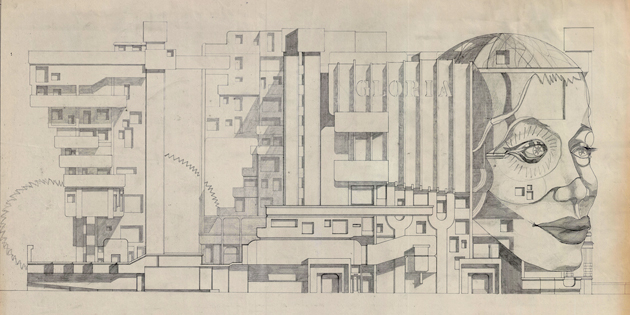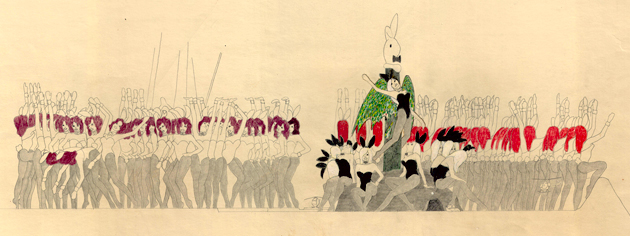|
|
||
|
Compared with the deconstructivist work of some of his fellow AA alumni, Shepheard’s pop-inflected compositions have left little impression on contemporary architectural culture. Charles Holland wonders why Paul Shepheard’s 1972 design for a Playboy Club on the Wiltshire plains must rank as one of the most extraordinary projects to have come out of London’s Architectural Association. Its outlandishness – a vast “henge” surmounted by larger-than-life playboy bunny-girls encircling a moated barrow – hits you first, followed by a subtler admiration for the delicacy of line and graphic restraint of the drawings. There are no plans or sections, only a long elevation through the landscape. Between the legs of the figures, a solitary speedboat can be seen making its way across the moat towards the island barrow. The interior remains unexplored and unexplained, although one can imagine it plays host to all manner of lascivious fantasies.
Shepheard’s Hotel Hank B: A fleet of Boeing 747s suspended in a permanent nose-dive while jet fighter planes streak off into the sky (AA Year 5, 1972, AA Archives) I have been fascinated by these drawings ever since I came across them in a book of AA projects edited by the late James Gowan. Recently, I was lucky enough to look through them with Paul Shepheard at the AA’s archive on Bedford Square. Close-up, the pop-fantasy of their graphic impact gives way to a surprising sweetness. The 2B pencil lines and hand-colouring are a picture of innocence, giving the project an appealing authenticity. There was another Shepheard project to look at too, an equally remarkable proposal involving a fleet of Boeing 747s suspended in a permanent nose-dive while jet fighter planes streak off into the sky around them. These drawings are beautiful and much of their enjoyment comes from the quality of their observation of the planes in flight as well as the sinuous curves of the fuselages and jet engines. This pleasure in mimesis, in the explicit use of figurative and recognisable imagery loosely co-opted into architectural compositions seems, in retrospect, a rare flowering of a pop sensibility in architecture. Shepheard attended the AA in the early 1970s and his contemporaries included Piers Gough and Alex Marshall, authors of other remarkable pop architectural visions. Marshall’s Gloria – a shopping complex in the West End of London crowned by a vast woman’s face – is fantastically brazen, a slightly unhinged pop brutalist mash-up. |
Words Charles Holland
Above: Part of Shepheard’s 1972 design for a Playboy Club on Salisbury Plain, Wiltshire (AA Year 5, AA Archives) |
|
|
||
|
Alex Marshall’s Gloria, a proposal for a shopping centre for London’s West End (AA Year 5, 1972, AA Archives) |
||
|
The drawings though are very different to Shepheard’s: messier and more gestural but also somehow more conventionally architectural. The figurative element, though undeniably forceful, is allied to a more conventional architectural form and programme. As a student, Gough designed a number of now near-legendary projects that combined visual wit and sophisticated draughtsmanship. Sweetest amongst them is undoubtedly the interior for a Cutler and Gross opticians, where the glasses are displayed on a dense arrays of faces arranged like audience members in a theatre where the eyes follow customers around the room.
Shepheard’s Playboy Club: a vast “henge” surmounted by larger-than-life playboy bunny-girls encircling a moated barrow During this period, the AA was going through a frenetic period of invention and innovation. Rem Koolhaas, Zaha Hadid, Nigel Coates, Peter Wilson and many others came through the school in those years, taught by Gowan along with Bernard Tschumi, Leon Krier and many other luminaries. While the deconstructive/late modern work of Koolhaas, Hadid et al has continued to shape architectural culture since, Shepheard’s pop-inflected work has left comparatively little impression. It’s worth asking why. Perhaps a mixture of architecture’s will to abstraction, the continuing influence of the narrower end of modernist ideology and too much English good taste has continued to repress the figurative/pop sensibility. But the visual wit of these projects, as well as the inventive way they engage with popular culture, surely still offers important pointers to an energised architectural language for our times. |
||
|
The outlandishness of Shepheard’s Playboy Club design hits you first, followed by a subtler admiration for the delicacy of line and graphic restraint of the drawings |
||























